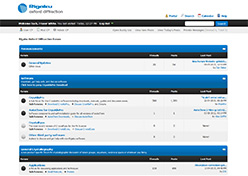|
Crystallography
in the news
June 1, 2017. A new study led by researchers at Fred Hutchinson Cancer Research Center completely mapped all mutations that help the HIV virus evolve away from a single broadly neutralizing antibody, known as PGT151. Broadly neutralizing antibodies are immune molecules that bind to viruses and can block them from spreading in the body.
June 5, 2017. HarkerBIO was formed in 2015 by Hauptman-Woodward Medical Research Institute, which is home to the Department of Structural Biology at the Jacobs School of Medicine and Biomedical Sciences, to commercialize Hauptman-Woodward???s expertise in X-ray crystallography.
June 13, 2017. A team led by Kathryn Hastie and Erica Ollmann Saphire at The Scripps Research Institute has solved the structure of the viral machinery that Lassa virus uses to enter human cells. Their study, published earlier this month in the journal Science, is the first to show a key piece of the viral structure, called a surface glycoprotein, for any member of the deadly arenavirus family, which also includes Ebola virus.
June 15, 2017. There are five key reasons why structural biology research excites researchers at The Institute for Cancer research: 1) It means we can look at proteins in atomic detail, 2) We can use X-ray crystallography and electron microscopy to "see" proteins, 3) We can use these techniques to make maps, 4) We're using state-of-the-art technology and 5) We want to use our knowledge of proteins to discover new drugs.
June 19, 2017. Chemists at Umeå University have succeeded in mapping structures and functions of a transient enzyme state. By modifying the enzyme adenylate kinase, researchers were able to isolate the molecule and study it using the quantitative techniques X-ray crystallography and nuclear magnetic resonance (NMR) spectroscopy.
June 19, 2017. An international team of scientists has for the first time used an X-ray free-electron laser to unravel the structure of an intact virus particle on the atomic level. The method used dramatically reduces the amount of virus material required, while also allowing the investigations to be carried out several times faster than before. This opens up entirely new research opportunities, as the research team lead by DESY scientist Alke Meents reported.
June 20, 2017. Researchers from USC and France identified that Bdf1, a gene-regulating protein, is critical for the survival of the pathogenic fungus Candida albicans. Their findings show that compounds that bind to this target will disrupt the growth of the fungus, opening the way to novel drug treatments for fungal disease.
June 20, 2017. Efforts in Brenda Schulman's lab at St. Jude, led by biochemist Daniel Scott, established how DCN1 interacts with other proteins and controls cellular processes. Their key discovery used X-ray crystallography to show that a small modification of the partner protein to DCN1, known as UBE2M, was required for DCN1 to work. This modification, N-terminal acetylation, while common, had not previously been shown to be critical to controlling activity of this specific protein.
June 22, 2017. Versant Venture and MPM Capital co-led a $68-million Series A fundraising round to establish Repare Therapeutics, a Canada-based cancer drug company exploiting a high-throughput, CRISPR-based screening platform to identify synthetic lethality cancer targets and develop precision anticancer therapies.
June 23, 2017. Philip Coppens, PhD, SUNY Distinguished Professor Emeritus and Distinguished Research Professor in the University at Buffalo Department of Chemistry, passed away on June 21. He was 86. A memorial service is being planned. More details will be available in the near future. Coppens was a pioneer in crystallography.
Product spotlight: CrysAlisPro
User-inspired software for superior data quality
Rigaku Oxford Diffraction systems come complete with CrysAlisPro, our user-inspired data collection and data processing software for small molecule and protein crystallography. Designed around an easy-to-use graphical user interface, CrysAlisPro can be operated under fully automatic, semi-automatic or manual control.
How to get CrysAlisPro
The software is freely available for users of Rigaku Oxford Diffraction instrumentation, and can be downloaded from our forum. Please register at www.rigakuxrayforum.com. Any queries related to the software may be answered on the forum.

A Full Complement of Crystallographic Tools
In addition to automatic routines, CrysAlisPro includes a very comprehensive and highly effective range of tools and functions for dealing with non-standard and problematic data. These tools are available through the GUI or from a command line interface, and include:
- Advanced unit cell finding
- EwaldPro – Reciprocal lattice viewer
- Twin data processing
- Incommensurate data processing
- Automated high pressure data collection and reduction
- Face-indexing – with automated shape generation
- Multi-temperature experiments
- Powder data collection and processing
- Precession image generation
- Axial photos
Software Compatibility
Use CrysAlisPro to import and process frames from synchrotrons and other detector formats. Data is automatically output in HKLF format and quick links interface directly to Olex2, CRYSTALS, WinGX and Jana (for use of SHELX, SIR, Superflip and other programs, where installed). Data files are also easily exported for use in third party data reduction packages including MOSFLM, DENZO and XDS.
For more about CrysAlisPro.
Lab in the spotlight
 Dr. John Bacsa
Dr. John Bacsa
Facilities Director
Crystallography Lab, Emory University
Our new diffractometer has arrived!
The Department of Chemistry at Emory University has been awarded a high-intensity dual-source microfocus X-ray diffractometer from the National Science Federation. The new equipment has been installed and includes the Rigaku PhotonJet equipped with multilayer optics, and the recently introduced Rigaku HyPix-6000HE Hybrid Photon Counting (HPC) detector. The advanced hardware, including a high-brilliance source and an HPC detector with small pixel size and zero background noise, will assist in collecting data from very small crystals, poorly crystalline materials, biological materials and even protein crystals.

The center is also beta-testing software for Dr Birger Dittrich, Georg-August-University, Göttingen, Germany and contributing towards a database of non-spherical scattering factors for charge density refinements. New scattering factors for atoms are calculated quantum mechanically (in collaboration with the Emerson Center) and included in the database to increase its coverage of chemical and biological environments. Additionally, a new 16 TB data server (xrayserv) has been installed, enabling archival of all X-ray data collected by the facility to be stored on-site.
The Rigaku XtaLAB Synergy diffractometer includes dual (copper and molybdenum) PhotonJet sources equipped with multilayer optics, and the recently introduced Rigaku HyPix-6000HE Hybrid Photon Counting (HPC) detector. The new technology of the microfocus source affords very strong, highly focused beam intensity with very low energy costs. The detector has zero-readout noise and a very high dynamic range so that reflections with very high and very low count rates can be measured simultaneously. The readout time is very low and we routinely measure data with 0.1 s exposures. The data collection, reduction, and structure determination is often complete in under 1 minute.

Useful link: Image Viewing and Analysis
Here is a link to a java based utility developed originally at NIH for viewing and analyzing microcopy images. The basic package comes with a large of number of tools and the community has developed many more sophisticated tools for image analysis. ImageJ is not limited to microscopy, and the utility can be used for analyzing just about any type of image in any format.

Selected recent crystallographic papers
MMTF—An efficient file format for the transmission, visualization, and analysis of macromolecular structures. Bradley, Anthony R.; Rose, Alexander S.; Pavelka, Antonín; Valasatava, Yana; Duarte, Jose M.; Prlic, Andreas; Rose, Peter W. PLoS Computational Biology. 6/2/2017, Vol. 13 Issue 6, p1-16. 16p. DOI: 10.1371/journal.pcbi.1005575.
Rosetta:MSF: a modular framework for multi-state computational protein design. Löffler, Patrick; Schmitz, Samuel; Hupfeld, Enrico; Sterner, Reinhard; Merkl, Rainer. PLoS Computational Biology. 6/12/2017, Vol. 13 Issue 6, p1-24. 24p. 2 Diagrams, 2 Charts, 6 Graphs. DOI: 10.1371/journal.pcbi.1005600.
Solving the crystal structure of human calcium-free S100Z: the siege and conquer of one of the last S100 family strongholds. Calderone, V.; Fragai, M.; Gallo, G.; Luchinat, C. Journal of Biological Inorganic Chemistry. Jun2017, Vol. 22 Issue 4, p519-526. 8p. DOI: 10.1007/s00775-017-1437-4.
CrystalWalk: crystal structures, step by step. Bardella, Fernando; Montes Rodrigues, Andre; Leal Neto, Ricardo Mendes. Journal of Applied Crystallography. Jun2017, Vol. 50 Issue 3, p949-950. 1p. DOI: 10.1107/S160057671700560X.
On the Ca2+ binding and conformational change in EF-hand domains: Experimental evidence of Ca2+-saturated intermediates of N-domain of calmodulin. Ababou, Abdessamad; Zaleska, Mariola; Pfuhl, Mark. BBA - Proteins & Proteomics. Jun2017, Vol. 1865 Issue 6, p640-651. 12p. DOI: 10.1016/j.bbapap.2017.03.003.
Metal-Coordination-Assisted Folding and Guest Binding in Helical Aromatic Oligoamide Molecular Capsules. Horeau, Maxime; Lautrette, Guillaume; Wicher, Barbara; Blot, Virginie; Lebreton, Jacques; Pipelier, Muriel; Dubreuil, Didier; Ferrand, Yann; Huc, Ivan. Angewandte Chemie. 6/6/2017, Vol. 129 Issue 24, p6927-6931. 5p. DOI: 10.1002/ange.201701693.
Carbamohydrazonothioate derivative—experimental and theoretical explorations of the crystal and molecular structure. Bankiewicz, Barbara; Wojtulewski, Slawomir; Markiewicz, Karolina; Wilczewska, Agnieszka. Structural Chemistry. Jun2017, Vol. 28 Issue 3, p801-812. 12p. DOI: 10.1007/s11224-016-0874-y.
X-ray crystallographic analysis and DFT calculations of three 'propylene linker' dimers linked by one polystep reaction. Shi, Yan; Tan, Xue-Jie; Xing, Dian-Xiang; Sui, Qi-Cheng; Liu, Bin; Feng, Wen-Quan; Liu, Yun. Journal of Molecular Structure. Jun2017, Vol. 1137, p126-135. 10p. DOI: 10.1016/j.molstruc.2017.02.006.
Protonation of Tetraphenyl- and 2,3,4-Triphenylcyclo-pentadienone – An NMR and X-ray Crystallographic Study. Harrington, Laura E.; Britten, James F.; Casey, Michael; Grealis, John; Ortin, Yannick; Müller-Bunz, Helge; McGlinchey, Michael J. European Journal of Organic Chemistry. 6/16/2017, Vol. 2017 Issue 22, p3249-3255. 7p. DOI: 10.1002/ejoc.201700019.
X-ray crystallographic analysis and DFT calculations of three 'propylene linker' dimers linked by one polystep reaction. Shi, Yan; Tan, Xue-Jie; Xing, Dian-Xiang; Sui, Qi-Cheng; Liu, Bin; Feng, Wen-Quan; Liu, Yun. Journal of Molecular Structure. Jun2017, Vol. 1137, p126-135. 10p. DOI: 10.1016/j.molstruc.2017.02.006.
Crystallographic Structure Determination of Both [5,6]- and [6,6]-Isomers of Lithium-Ion-Containing Diphenylmethano[60]fullerene. Hiroshi Okada; Hiroki Kawakami; Shinobu Aoyagi; Yutaka Matsuo. Journal of Organic Chemistry. 6/2/2017, Vol. 82 Issue 11, p5868-5872. 5p. DOI: 10.1021/acs.joc.7b00730.
Crystallographic and optical properties of CuInS2-Cu2ZnSnS4 crystals. Oishi, Koichiro; Shimizu, Wataru; Takeuchi, Akiko; Nishida, Genki; Yamazaki, Makoto; Nakagawa, Masato; Aoyagi, Naritoshi; Katagiri, Hironori. Physica Status Solidi (B). Jun2017, Vol. 254 Issue 6, pn/a-n/a. 5p. DOI: 10.1002/pssb.201700112.
Serial electron crystallography: merging diffraction data through rank aggregation. Smeets, Stef; Wan, Wei. Journal of Applied Crystallography. Jun2017, Vol. 50 Issue 3, p885-892. 7p. DOI: 10.1107/S1600576717005854.
The exocyclic amino group of adenine in PtII and PdII complexes: a critical comparison of the X-ray crystallographic structural data and gas phase calculations. Silaghi-Dumitrescu, Radu; Mihály, Béla; Mihály, Timea; Attia, Amr; Sanz Miguel, Pablo; Lippert, Bernhard. Journal of Biological Inorganic Chemistry. Jun2017, Vol. 22 Issue 4, p567-579. 13p. DOI: 10.1007/s00775-017-1448-1.
Searching for stereoisomerism in crystallographic databases: algorithm, analysis and chiral curiosities. Grothe, E.; Meekes, H.; de Gelder, R. Acta Crystallographica: Section B, Structural Science, Crystal Engineering & Materials. Jun2017, Vol. 73 Issue 3, p453-465. 12p. DOI: 10.1107/S2052520617001962.
Direct protein crystallization on ultrathin membranes for diffraction measurements at X-ray free-electron lasers. Opara, Nadia; Martiel, Isabelle; Arnold, Stefan A.; Braun, Thomas; Stahlberg, Henning; Makita, Mikako; David, Christian; Padeste, Celestino. Journal of Applied Crystallography. Jun2017, Vol. 50 Issue 3, p909-918. 9p. DOI: 10.1107/S1600576717005799.
Complexation of a Globular Protein, β-Lactoglobulin, with an Anionic Surfactant in Aqueous Solution. Yan Li; Takahiro Sato. Langmuir. Jun2017, Vol. 33 Issue 22, p5491-5498. 8p. DOI: 10.1021/acs.langmuir.7b00941.
Tailoring thermal treatment to form liprotide complexes between oleic acid and different proteins. Sørensen, Henrik V.; Pedersen, Jannik N.; Pedersen, Jan Skov; Otzen, Daniel Erik. BBA - Proteins & Proteomics. Jun2017, Vol. 1865 Issue 6, p682-693. 12p. DOI: 10.1016/j.bbapap.2017.03.011.
Development of Energy Scanning Software to Facilitate MAD Experiment at PX-BL21, Indus-2 Synchrotron. Dwivedi, Abhilash; Kumar, Ashwani; Ghosh, Biplab; Poswal, H. K.; Makde, Ravindra; Sharma, Surinder M. AIP Conference Proceedings. 2017, Vol. 1832 Issue 1, p1-3. 3p. 2 Diagrams, 2 Graphs. DOI: 10.1063/1.4980418.
Book review
Not a Scientist: How Politicians Mistake, Misrepresent, and Utterly Mangle Science by David Levitan, W. W. Norton & Company, New York, 2017, 272 pages, ISBN-13: 978-0393353327
 This is another book I learned about on Science Friday. The author is a science journalist whose credentials include a Master's in journalism from NYU and published articles in periodicals like Scientific American and Time.
This is another book I learned about on Science Friday. The author is a science journalist whose credentials include a Master's in journalism from NYU and published articles in periodicals like Scientific American and Time.
The author walks the reader through thirteen different methods politicians use to attempt to debunk science. Most of the book was written before 11/9/16, but the Foreword does cover more recent events. The author goes through each of the methods, which you will likely recognize, and provides real-life examples of how politician used them. Here are the tricks of the trade:
The Oversimplification, The Cherry-Pick, The Butter-up and Undercut, The Demonizer, Blame the Blogger, Ridicule and Dismiss, The Literal Nitpick, The Credit Snatch, The Certain Uncertainty, The Blind Eye to Follow-up, Lost in Translation, The Straight-up Fabrication and last but not least Conspicuous Silence.
The author attempts to alert us to politicians who use these tricks and what to do to combat them. Some are so ludicrous you will laugh, but then you will either get mad or sad because these lies live on. The book is a quick and easy read, and while numbers are discussed, this is done only to illustrate how data is easily manipulated to "prove" a desired point.
Review by Joseph Ferrara
Deputy Director, X-ray Research Laboratory, Rigaku
|











